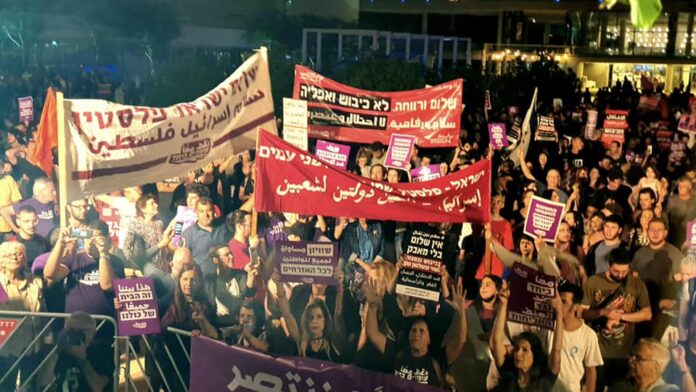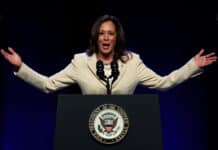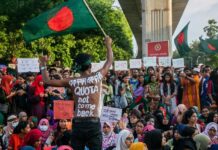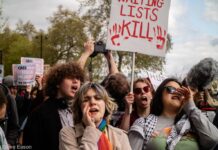Fighting for international solidarity and a socialist solution
internationalsocialist.net
The uprising of Palestinian youth on both sides of the ‘Green Line’ (pre-1967 border) in the West Bank and in Israel, the massacre in Gaza and solidarity demonstrations in Israel, have put the oppression of the Palestinians at the centre of international attention. This will not disappear with the ceasefire but continue and deepen. Now, the Israeli state has launched a crackdown on Palestinian youth who participated in protests over the past month.
The massive ‘Nakba’ mobilisations which took place around the world this month, and countless spontaneous mobilisations since then, suggest that Palestinian oppression is once again becoming an important factor in the radicalisation of young people worldwide. This is taking place at a time of increased opposition, among young people worldwide, to all forms of oppression as was previously expressed in the massive character and international spread of the fight against racism during the Black Lives Matter movement and in the fight against sexism.
For eleven days, the Israeli state bombed Gaza. At least 248 people were killed in Gaza, including 66 children. More than 1,900 people were wounded while hospitals were inaccessible if not bombed. Close to 2,000 homes were destroyed. In the context of this bloodbath, at least 12 people, including children, were also killed by rockets fired from Gaza, including Palestinians, Jews and immigrants.
The fact that this happened in the midst of the Covid pandemic makes things even worse and has undoubtedly contributed to the international protests and radicalisation. Israel is the international leader in vaccination, but in the West Bank and Gaza, vaccination has hardly begun. The fact that a ceasefire has now been concluded and seems to hold for the time being is a relief, but it has not solved any of the fundamental problems. The occupation of the West Bank, the blockade of Gaza, unemployment, poverty, misery and discrimination continue, as does the revolt of Palestinian youth. Whether the most recent crackdown, with door-to-door searches for Palestinian youth who participated in the protests and mass arrests in East Jerusalem and other communities, will dampen the mood or inflame further resistance, is still difficult to judge.
Crisis situations such as the one that has developed since April, with many sudden twists and sharp changes, are a test for all social forces: for the regime in Israel, the Palestinian Authority and the Palestinian political groups in the first place, but also for US Foreign Policy under President Biden and those Arab regimes that recently established diplomatic relations with Israel in the context of “normalisation”. It challenges the balance of power in the region, including the growing alliance between some Sunni Arab dictatorships and the Israeli regime, partially as a counterweight to the rival Iranian regime and its allies. However, this situation also poses enormous challenges to the labour movement and youth movements internationally and in the region, as well as to ISA and its section in Israel/Palestine to both stand firm on its principles and be sufficiently flexible in its approach.
Provocations lead to youth revolt
The immediate triggers for the Palestinian youth-led uprising were dispossessions of 19 Palestinian families in the Sheikh Jarrah neighbourhood to house far-right Jewish settler — as part of the so-called ‘Judaisation’ of East Jerusalem — and the provocations by the Israeli regime during Ramadan when police stormed Al Aqsa Mosque and cordoned off the Damascus Gate.
There is no doubt that cynical political calculations by Israeli Prime Minister Netanyahu played into those provocations. He is on trial for various corruption charges, which have been a focal point for a massive protest movement in Israel last year, and he is fighting for his political survival. In four elections in two years, he has failed to form a majority coalition in the Knesset (parliament). He has pulled out all the stops, strengthening the far-right Kahanists and forming an alliance with them, while at the same time posing as “Abu Yair” (father of Yair, Netanyahu’s eldest son) to gain votes from Arab-Palestinian citizens of Israel and angling for support from the Islamist Mansour Abbas’ United Arab List.
The provocations in East Jerusalem undermined the chances of an alternative anti-Netanyahu government being formed around the “bloc for change” led by Lapid and the even more right-wing Bennet, with the participation of the “left-wing” Meretz, Labour and the United Arab List. The fact that the leaders of the “bloc for change”, including Labour, unambiguously backed Netanyahu in his repression of the Palestinians and subsequently in the war on Gaza, exposes their bourgeois sham in posing as an alternative.
But the roots of the crisis lie deeper than Netanyahu’s cynical calculations: in the systematic and orchestrated politics of maintaining the capitalist status quo of occupation of the West Bank and the annexed East Jerusalem, the settlements, the siege of Gaza, national discrimination, ‘divide and rule’ methods and poverty. This status quo, in the post-Trump era and with a protracted governmental crisis in Israel, is meeting with increasing courage and resistance on the part of a new generation of Palestinians prepared to confront the Israeli regime.
The mass uprising by Palestinian youth forced through a number of important victories: the Supreme Court hearing on the Sheikh Yarrah case was postponed, the blockade of the Damascus gate was lifted and a provocative far right flag parade was diverted. In essence, this is an incipient third ‘Intifadah’, an uprising for national liberation against oppression, dispossession, poverty and misery.
From revolt to war
Palestinian youths have taken the reins themselves. They see the Palestinian Authority and Fatah leadership as powerless at best, usually as collaborators with the occupation. Their trust in the Palestinian political factions is low and the call for Abbas’ resignation, especially since the ceasefire in which he played no part, is getting louder. Marwan Barghouti, an opponent of Abbas who earlier stood as a candidate in the Palestinian elections from an Israeli prison with his own independent list, must have sensed the changed mood. However, the Palestinian elections, the first for 15 years, have again been postponed indefinitely.
Despite the tactical victories won by Palestinian youth on the ground, the Hamas leadership continues to consider it naive and futile to suggest that mass action, civil disobedience and popular struggle can deal decisive blows to the Israeli regime and achieve significant concessions. It praises the uprising of the youth, but in fact does not trust their ability to change the balance of forces on the ground without the Hamas militia getting involved. The ultimatum issued by its military wing to Israel, at the height of the youth rebellion, is a symptom of its overall vision of mass struggle as secondary to military firepower.
Hamas intervention was also a political move. It is under pressure because living under the blockade is untenable and it cannot find a way out. It leads to discontent from below, which is reflected in discord at the top. Hamas knew that a military confrontation with Israel would come at a high cost in terms of human lives, but it was a calculated gamble to restore unity in Gaza, demonstrate the strength of its militias and establish itself as the leader of the Palestinian liberation struggle, including in the West Bank and Jerusalem.
To a certain extent, as soon as the first rocket salvo was launched, Hamas reached its immediate political aims. After the truce, which is celebrated as a victory not only in Gaza but also among the Palestinians in general, green Hamas flags dominated not only in Gaza but were also prominent in East Jerusalem and even in Ramallah, the bastion of Fatah.
The Palestinian people are right to fight for liberation and against oppression. This goes hand in hand with the right to defend themselves, including by force of arms. But indiscriminate rocket attacks from Gaza also gave the right-wing Israeli regime the opportunity to turn its repression of a popular uprising into a so-called war of defence. War is a continuation of politics by other means.
There is no doubt that the firepower of the Palestinian militias was a blow to the prestige of the Israeli regime whose “iron dome” (anti-missile system) was severely tested. It shattered the illusion spread by the Israeli regime that it has an impenetrable deterrent force in place. At the same time, this war was very ‘one-sided’: a war on the Palestinians, referred to by many correctly as state terror. It has aroused enormous indignation both in the region and internationally.
Conditions have changed
This time, the situation was very different from the previous Gaza war in 2014. Then the carnage continued for 51 days. It was after the counter-revolution which followed the so-called Arab Spring revolutions had been consolidated in a number of neighbouring Arab countries. This time, there were almost immediate mass protests in Tunisia, Iraq and Jordan, among others. For the first time since 2011, the border with Lebanon and Jordan was briefly breached. The Palestinian diaspora began to stir, with militias in Lebanon firing projectiles into Israel.
The scale of the Palestinian uprising on both sides of the Green Line had not occurred since the beginning of the second intifadah in 2000. The Israeli regime was faced with a struggle on four fronts: in Gaza, the West Bank, annexed East Jerusalem and in the streets of the so-called mixed cities of Israel. The illusion that Israel would succeed in isolating the Palestinians and discouraging them in their struggle for national liberation by strengthening relations with a number of Arab dictatorships in the region has now been shattered. The “normalisation” process had slowed down anyway, but risked being significantly thrown back if Israel had embarked on a ground invasion.
On three occasions, Biden blocked a Chinese-led condemnation of the continued violence in the UN Security Council, as well as opposing a French proposal. He did this despite pressure from the left-wing Democrats and from public opinion in the US, which sees in the situation of the Palestinians similarities with the plight of black people in America. In exchange, he undoubtedly made it clear to the Israeli regime that it would have to swallow a quick truce without additional conditions. The international solidarity demonstrations, especially on the day of Nakba remembrance, including in the region itself, increased the pressure for this.
Elements of civil war
An important factor is the relatively increased weight of the extreme right in Israel. Netanyahu himself helped three extreme right-wing groups unite on one list, and mobilized a mass of his own supporters to tactically vote for them, so that they would reach the electoral threshold, to secure his right-wing bloc. This artificial boost gave them more access to the media, got them elected and gained them self-confidence. It led to violent confrontations and riots in a whole series of cities and towns.
Gangs of far-right Kahanists, including armed settlers, criss-crossed municipalities in pursuit of Palestinians. The police, who brutally suppress Palestinian protests, usually just stood by and watched. Outright lynchings were carried out. In Lydda, a Palestinian was shot. Some of these lynchings were picked up by the media. They aroused disgust. It is also within the context of the organized violence against the Palestinians that Palestinian nationalist attacks and attempts at lynchings occurred. This enabled Netanyahu to condemn the use of violence “from both sides”.
In general, however, this situation led to a movement of solidarity throughout the country between Jews and Palestinians under slogans such as ‘Jews and Arabs refuse to be enemies’. In response to these confrontations, “superbus” bus drivers, organized in the ‘Power to the Workers’ union, laid down tools and Jewish drivers escorted their Palestinian colleagues safely back home. In Jerusalem, teachers declared their solidarity with a protest strike by Palestinian students. The social workers’ union published a statement saying that it represents “all social workers in Israel, of all nationalities and religions, and with a variety of philosophies.” Even politicians from the hard right were compelled by the pressure to pay lip service against the violence, and some companies attempted to gain publicity with similar statements. Of course, this is not yet a clear opposition to the war and occupation, at most a message in support of ‘coexistence’, but it is still a development that should not be underestimated.
Local committees and Palestinian strike
Provocations in Jaffa, the historic Palestinian town that has now become a district of Tel Aviv and still has a significant Palestinian population, led to the formation of a ‘defence committee’ against gun violence and Kahanists.
In the coming period, it will be important to further develop the struggle against the occupation, the blockade, discrimination, poverty and capitalism, on both sides of the Green Line, with more demonstrations, more strikes, and more actions of civil disobedience. This also requires the formation, expansion and coordination of democratic action or defence committees, some of which already exist.
This is not simply a question of organisation, but also of democratic discussion and the elaboration of a programme. After all, defeating Israel’s military machine is first and foremost a political question, a question of which programme can most effectively unite the working class and youth in a common struggle against exploitation and oppression.
A particularly important moment was the Palestinian strike last Tuesday, 18 May. It was called, under pressure from below, by the ‘High Arab Follow-up Committee’, an umbrella organisation of all Palestinian political parties in Israel established after the massacre in Palestinian refugee camps of Sabra and Shatilla near Beirut (1982). This is not the first time this has happened. The follow-up committee regularly calls for such strikes, but this time, the mobilization was extraordinary.
In East Jerusalem, in the West Bank, in the Druze villages in the Golan area and in many so-called mixed cities in Israel, the call to strike was heeded en masse. This was despite the threat of being sacked, despite the fact that many will end up on a blacklist, despite the fact that some 1,500 Palestinians were arrested and Kahanists searched for strikers on facebook pages to demand their dismissal.
It was an active strike, with pickets and in some places barricades. According to Haaretz, it illustrated Israel’s dependence on Palestinian workers and the strike is said to have cost about $40 million. The manager of a cleaning employers organization declared “without them we cannot work”. The Israeli Construction Association stated that only 150 of the 65,000 Palestinian construction workers were working on Israeli sites. According to the Ministry of Transport, 10% of all bus drivers did not turn up. The follow-up committee estimated the number of strikers at more than half of the Arab public.
It became a show of force that at least some Jewish workers also understood and in that sense an episode which strengthened all workers. The leadership of Histadrut (the main Israeli union federation) refused to recognise the strike and even called on dockers to boycott Italian ships in response to the refusal of dockers from Livorno to handle military equipment for Israel. The Electricity Company workers’ committee even made a reactionary call for no power lines to be restored to Gaza. But there were also some declarations of solidarity by Jewish workers with their colleagues. It immediately became clear what economic power the Palestinian workers possess.
An ultimate test
A crisis situation like this is also an ultimate test for revolutionary parties. It is a question of resisting the patriotic pressure that comes with such developments, the demoralising effect it can have on militants, the tendency to abandon a class approach and to allow oneself to be dragged along by a tide of “national unity” among the oppressed, even with reactionary and bourgeois forces. And to resist the tendency for the hatred of the oppressor to turn into a hatred of the working class of the oppressing nation.
We often have to swim against the stream, but in such a situation it can be unbearably hard. To continuously engage in political work around a carefully-designed programme which takes a sensitive approach, while remaining principled, and at the same time to translate this program into concrete action is a huge challenge. Socialist Struggle, (ISA in Israel/Palestine), succeeded in this challenge on both sides of the Green Line, which puts us in a more favourable position today.
Our programme is, of course, based on a series of immediate demands: an end to the war through mass mobilisation, to police and military repression against protests, to attacks on civilians, to the deployment of security forces at Al Aqsa, to far-right provocations, to expropriations in Sheikh Jarrah and to the expulsion of the Palestinian inhabitants of East Jerusalem. We connect this to the need to end the settlement policy, express solidarity with war victims of all communities, and call for an end to the siege and blockade of Gaza and the collective punishment of its population.
We stress that peace is impossible without a struggle against occupation, poverty and inequality, against corrupt elites, and for healthcare, livelihoods and welfare for all in the region. We call for unity among workers and youth, for solidarity in workplaces and campuses against nationalistic “divide and rule” methods, against the extreme right, and against escalation. We are in favour of setting up action committees for self-defence and the democratic organisation and spreading of the struggle. We are against the denial of Palestinians’ right to self-determination, for an independent socialist Palestine with its capital in East Jerusalem, and for socialist change in Israel and the region.
The evolution of our programme
A socialist programme must respond to the concrete situation. Since the situation is constantly changing, the programme must also be constantly adapted to the concrete requirements of a given moment.
In 1948, the Marxists opposed the creation of Israel. After all, the Zionists’ answer to the ‘Jewish question’, a homeland for Jews in Palestine, meant denying that same right to the Palestinians. It could only be done by the violent expulsion of the Arab population. Inevitably, such a Jewish state, in order to survive, would have to be over-militarised and an instrument of imperialism. The crime of anti-Semitism thus led to the crime of Zionism, a crime against the Palestinian people.
The Arab ruling elites were divided and played off against each other by imperialism. They manoeuvred among themselves and shared only their rhetorical condemnation of Israel. On this basis, Israel was able to consolidate itself and, in 1967, to conquer the West Bank and Jerusalem, among other things. This was not a solution, it only provoked greater hatred among the Arab masses. In 1967, our forerunners wrote that only under the leadership of the working class was it possible to build a democratic federation of all Arab states, including Israel as an autonomous region and with full equal rights for all minorities, including the right of return for Palestinian refugees who so desire.
In the meantime, generations of Jews have grown up in Israel, a society torn by class division, plagued by discrimination, unemployment, a housing crisis and poverty. The reactionary idea of “driving the Jews into the sea” is militarily out of the question, and its existence only strengthens the grip of Zionist reaction over the Jewish population.
On a capitalist basis, both a single “binational” state and a two-state solution are utopian. The Israeli ruling class has no interest in giving equal access to its state to millions of Palestinians and a Palestinian state would at best be a vassal state, unable to solve the problems of continued national oppression, poverty and unemployment for the Palestinian masses. The expansion of the colonies in the West Bank has divided the area into separate enclaves with the aim of crushing the hopes of the Palestinians for their own state.
In these circumstances, only a mass struggle for national and social liberation can offer a way out. The Palestinian youth uprising and general strike indicate how this struggle could be developed and expanded to all the Palestinian communities within the 1967 and 1948 borders and throughout the region. This movement can appeal to workers, youth, and oppressed communities within Israeli society and help to develop the struggle against Israeli capitalist state, it’s repressive measures, “divide and rule” policies, attacks on workers and social misery. A socialist Palestinian state with East Jerusalem as its capital and a socialist transformation of Israel as part of a socialist confederation in the Middle East is the only way to end occupation, discrimination, poverty, exploitation and war. In the past, we advocated Jerusalem as a common capital, but the politics of dispossession of Palestinian families and of Jewish settlements means that it has been necessary to underline even further the need for an equal status of two national capitals in Jerusalem.
A socialist plan of production for the entire region and cooperation between the different communities would make it possible to organise the return of Palestinians who so wish, to discuss borders democratically, including an expansion of the territory of Palestine, and to dismantle the settlements in the West Bank. Only then would peace in the region and prosperity for all be possible.




